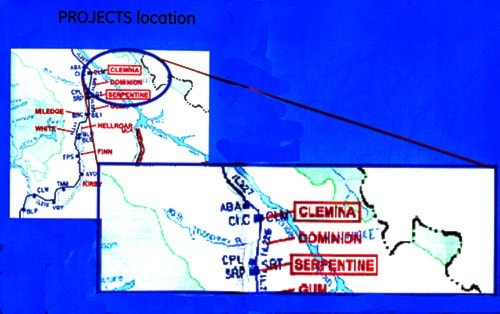TransAlta has sold its rights to several partially completed small scale hydro projects in the North Thompson Valley, according to Doug Brown, band manager with Simpcw First Nation.
The buyer, Sorgent.e, is an Italian company that specializes in developing hydro and wind power projects around the world.
“They are extremely capable in these projects,” Brown said.
TransAlta continues to own and operate its small-scale hydro project at Bone Creek north of Blue River.
The Simpcw have had excellent relations with TransAlta, said Brown. The band expects those relations to continue with Sorgent.e.
However, the band has not had such good relations with the promoters of the Holmes River hydro project in the McBride area.
Simpcw First Nations’ good relations with TransAlta go back to an impact and benefits agreement negotiated with its predecessor company, Canadian Hydro Developers, said Brown.
That agreement carried on when TransAlta took over the smaller company in 2009. It resulted in contracting and employment opportunities for band members during construction of the 19 MW Bone Creek facility, as well as royalties to the band now that it is operational.
The recently concluded sale to Sorgent.e included fully permitted projects on Clemina and Serpentine creeks. Both would have 11 MW capacity and would involve investments of about $45 million each.
Much of that money would stay in the economies of the North Thompson and Robson valleys, Brown pointed out.
Access roads, power-line modifications and ancillary works have already been done. There are even turbines on site, ready to be installed.
If all goes well, construction of the two projects could begin in the second half of 2013 and last about 30 months.
About 350 workers would be employed on site at each project during construction.
Sorgent.e also bought the rights for small-scale hydro projects on Dominion, Gum, Miledge, Hellroar, White, Finn and Dominion creeks. All seven are in early stages of development
One possible sticking point with the Clemina and Serpentine projects has been the limited capacity of BC Hydro’s transmission line up the North Thompson Valley, said the band manager.
“The Simpcw and the non-Aboriginal communities in the valley have been telling BC Hydro that a priority for development is to expand the electrical capacity in the valley,” Brown said. “Quite a few economic development projects are waiting on it, for example, Yellowhead (a proposed copper-gold-silver mine near Vavenby), Ruddock Creek (a proposed lead-zinc mine near Tum Tum Lake), Commerce Resources (a proposed rare earth mine north of Blue River) and bio-energy production. Without reliable, three-phase power, it would be difficult to carry out any of them.”
Because of the limited capacity, BC Hydro has prioritized the small-scale hydro projects that will be connected, said the Simpcw band manager.
Holmes River Hydro has been given a higher priority than the Clemina and Serpentine projects.
Under the Delgamuukw decision in the Supreme Court of Canada, there are three obligations by the Crown if resource development infringes in Aboriginal title, said Brown.
These are meaningful consultations, good faith negotiations, and fair compensation.
There have been piecemeal attempts by Holmes Hydro Inc. to meet those requirements, but they are not considered meaningful by the band, said Brown.
Recently the David Suzuki Foundation and Salmon Watch launched legal challenges against the Holmes River project, saying it should have undergone a full environmental assessment.
Last week Chief Rita Matthew sent a letter to Minister of Energy Rich Coleman asking why the Holmes River project was allowed to go ahead without a full environmental review.
The project consists of 10 small sub-projects. None of them individually was big enough to trigger the 50 MW threshold for a full environmental assessment, but taken together they total 76 MW.
“The proponents of Holmes River hydro have never dealt with the Simpcw in a cooperative and forthcoming way to give economic benefits to compensate for the project’s impact,” said Brown.
“Any benefits that the Simpcw get would be shared with the non-aboriginal communities in the valley – spending on goods, services, contracts and so on. There would be significant multiplier effects outside of Simpcw First Nation itself,” he added.
